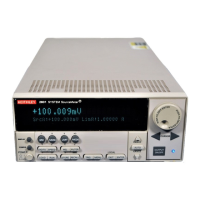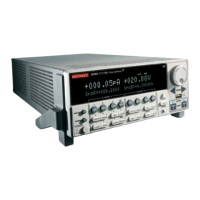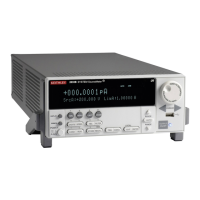2600AS-901-01 Rev. B / September 2008 Return to Section Topics 14-5
Series 2600A System SourceMeter® Instruments Reference Manual Section 14: System Expansion (TSP-Link)
System behavior
Using the reset () command
While most TSP-Link operations target a single node in the system, the reset() command affects
the system as a whole. The
reset() command, by definition, resets all nodes to their default
settings:
-- Resets all nodes in a TSP-Link system.
reset()
node[N] and localnode can be used with reset to reset only one of the nodes. The other nodes
are not affected. Examples:
-- Resets node 1 only.
node[1].reset()
-- Resets node 1 only.
localnode.reset()
-- Resets node 4 only.
node[4].reset()
Abort
An abort will terminate an executing script and return all nodes to local operation (REM
indicators turn off), dissolving the Master/Slave relationships between nodes. An abort is invoked
by either issuing an
abort command to the Master or pressing the EXIT key on any node in the
system.
An abort can also be performed by pressing the OUTPUT ON/OFF key on any node. The results
are the same as above, with the addition that all SMU outputs in the system are turned off.
Triggering with TSP-Link
TSP-Link has three synchronization lines that function similar to the Digio synchronization lines.
See
Section 8 and Section 10 for more information.
TSP advanced features
Use the TSP advanced features to run test scripts in parallel, to manage resources allocated to
test scripts running in parallel, and to use the data queue to facilitate real-time communication
between nodes on the TSP-Link network.
Running test scripts in parallel improves functional testing, provides higher throughput, and
expands system flexibility.
There are two methods you can use to run test scripts in parallel:
• Create multiple TSP-Link networks
• Use a single TSP-Link network with groups
Figure 14-2 displays the first method, which consists of multiple TSP-Link networks. Each TSP-
Link network has a master node and a GPIB connection to the PC.

